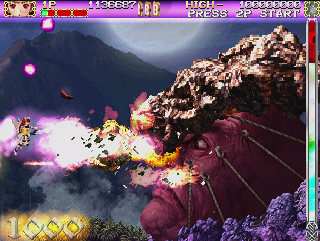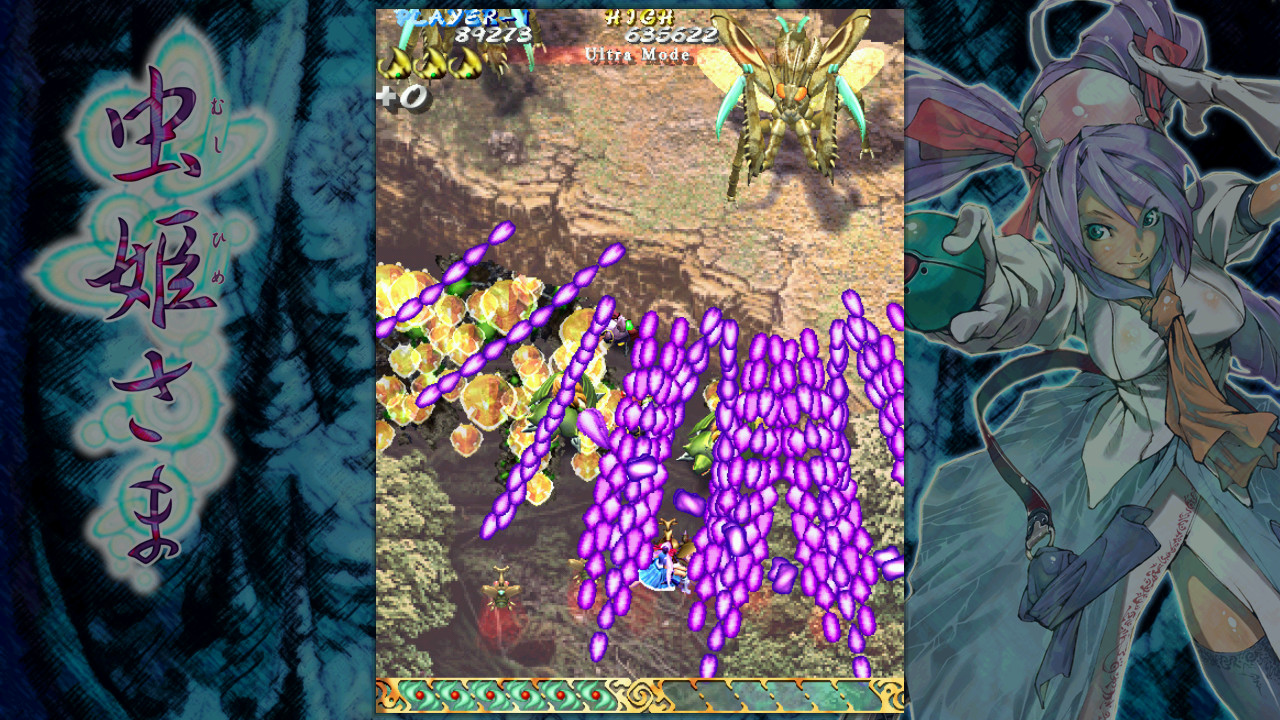On February 6th 1991, the scrolling shooter (STG, shmup), one of the oldest genres of computer game died. It's been in denial but the fatal blow was struck on that day. Much like how early arcade games like Pong, Space Invaders and Donkey Kong forever dethroned pinball as the primary appeal of game arcades, so too did Street Fighter 2: The World Warrior kill the scrolling shooter.
Game developers processed their grief in various ways. Compile (ZANAC, Aleste) struck gold with their versus puzzler spinoff of an RPG (Puyo Puyo!). Konami (Gradius) already had plenty of other projects but the Gradius 3 team in particular successfully turned their attempt at simulating interpersonal relationships into a cultural juggernaut. Taito (Space Invaders, Darius, Metal Black, Elevator Action, so many good games you should play) would continue to follow their akashic record until this false prophet ultimately resulted in them selling to Square Enix. Toaplan (Zero Wing, Same! Same! Same!/Fire Shark, Tatsujin/Truxton) would release an experimental shooter in Batsugun, release a sequel to Snow Bros. and then declare bankruptcy two years before Batsugun would be ported to the Sega Saturn by Banpresto. Even Irem, after years of bleeding their best artists to what would become the art team for Metal Slug would abandon shooters after R-type Final in favour of pachinko simulations that doubled as open world lesbian RPGs.
The scrolling shooter wasn't murdered. It was squeezed out of a market by fighting games' greater revenue potential. Why spend your money only to explode on a shooter's second stage when a single coin can carry you for hours so long as you keep winning fights? After all, you're the only Guile in your area who's worked out the double stun off jabs. It's not like anyone's going to know how to air throw you while standing...
...anyway shooters didn't die because they stopped being enjoyable to make or to play. They died because there was something enjoyable in a different way that was more appealing to arcade operators. This meant that from the ashes of 80s game developers came new teams who did not want to go gently into that good night. Raizing (Mahou Daisakusen, Battle Garegga, Soukyuugurentai) would experiment with what the goal of a shooter should be in various ways. Psikyo (Gunbird, Sengoku Blade, Strikers 1945) and Seibu Kaihatsu (Raiden) would dare players to dodge bullets at supersonic speeds. Former Taito employee Junya Ota would change the Japanese independant music and art scenes forever with his games about a shinto priestess and a witch beating up fairies and spirits with dazzling patterns of slow-moving bullets.
And then there's Cave.
From their founding in May 1994 until their final arcade game in 2012, there has never been a company so feverishly devoted to doing as much with a single game genre as this developer. 2D shooters can be built fairly quickly so we're talking as many as three full game releases in a single year. Take 2007: there's a game built around dynamic resource management, a complete systems overhaul of a previous title with an entirely new endgame and a game aimed at newcomers with systems and level design that allows for veterans to have their asses kicked with very little menu navigation! Cave games aren't just mechanically satisfying; they're masters of that nebulous gamefeel. Movement is crisp. Transitioning between attack styles is fluid. The explosions are gorgeous. Shiny items and numbers continually pump dopamine into your brain. Raizing's restructuring in late 2000 mean most games feature a Manabu Namiki soundtrack that kicks down your door for a sudden rave when you so much as start to select a ship. Did I mention that time you have to blow up a giant funny face?

Or how about those two games from like 2003 and 205 where everyone is trans? Point is, Cave's games aren't just well designed games (because they sure as hell aren't programmed well). They're cool as shit.
Yet, as the company has pivoted towards their (insanely experimental) mobile phone game Gothic wa Mahou Otome, re-releases of their games to newer hardware don't start where you'd expect. They don't begin with Donpachi and Dodonpachi, the first two games. Publishers aren't gunning for you to play Guwange the Edo period samurai youkai-busting game filled with blood and cat-spiders even when Kinetsu no Yaiba is what The Teens are into. Hell, their final game is dangerously Anime(tm) and it's stuck on the Xbox 360 and exA Arcadia. So what do they release if it's none of what you might think would be signiature Cave games?
Mushi.
It's always Mushi first.

I never cared that much for Mushihimesama. In a company portfolio where your average game has giant lasers, screaming synths or the absurd rules of Shinobu Yagawa's works it was always just... there. A simple game where you pick up items to improve your shot and gain extra pods for some small lasers. A game where you shoot the bad insects, pick up their scales for points and try not to touch the glowing purple stuff. Maybe you use one of your emergency bomb stocks if worried. The same old story since Xevious and Fantasy Zone without even the latter's shop gimmick.
I should talk about Mushi's difficulty selection. See, some of Cave's signiature games have secret conditions that when fulfilled make you play the game a second time once you've won. This might involve maintaining a high combo chain, finding secret items or only using a single credit. At its most extreme in Ketsui: Kizuna Jigoku Tachi you will reach the second loop if you have a combined total of six or less deaths taken and bombs used. If that number is zero you instead go to an even harder second loop with the true last boss. It means that nearly twenty years since the game's release, any demonstration of the game is a tense thrill ride. To even see the fancy hardcore elements requires completely perfect play from a human for nearly half an hour. This design leads to a dilemna: if a player is skilled enough to reach this second loop consistently, then isn't the first run completely redundant? As a result of this, games start ditching the second loop and just let you select it from the start of the game.
| These modes should really be "Hard", "A Bit Harder" and "Fuck You" |
Hang on a second, aren't there three modes there? Shouldn't the menu only need two if it's meant to just be "Loop 1" and "Loop 2"? That's where the slow burn joy of Mushi begins. The first two options aren't really difficulty tiers the way you might think. They're styles of play. Maniac is what you would expect from a game by Cave in 2004. Lots of slow-ish bullets, though faster than a Touhou game. Some weird scoring mechanics to sink your teeth into. Two extra lives from reaching score thresholds and one for fulfilling a weird condition halfway through the game. In this case, that one requires defeating the head of the Stage 3 battleship bug (which by the way rules as a setpiece) without a bomb being active as it dies. Original mode though? While considered a little bit easier than Maniac, it operates at a completely different pace. It's closer to one of those Seibu Kaihatsu or Psikyo games I mentioned. Bullets are sparse but move so goddamn fast. So fast they kicked my ass and I quit.
Then I played a bunch of Dangun Feveron. It's the fastest game Cave ever made. A throwback to the days several staff still worked at Toaplan. You need to collect cyborgs before they fall off the top of the screen. You dance to disco music until a boss revs up the electric guitar. Most importantly: you continually sway left to right and down to up in a frenzied panic to kill enemies before they fire. You don't need to dodge if the enemies are already dead!
It was after some of that fever entered my body that I returned to the bugs. An epiphany struck me: "I need to play this like Feveron". See, before I took to the game with a mindset similar to a Touhou game. This sort of laid-back subtle dodging of the bullet patterns while whittling down enemies with a spread shot. Feveron changed me. I selected the narrowest shot type with the fastest movement. I began to play a Cave game like I was using Bullet.
Baptised in the purple bullets I became a changed man. The more... videogamey soundtrack ceased to feel like less of a cancelled rave and more of a diegetic adventure through the forest. The gorgeous, colourful array of insects became friends (well, except those asshole crickets on stage 4.) Stage 4's dragonflies become a delightful puzzle to solve. The bomb changed from a reminder of how simpler the game is over something like Dodonpachi Resurrection and instead my teal-coloured friend. What's more, the game stopped feeling like a game missing the mystique of Cave as a brand and something much more cheerful.
Mushihimesama is a celebration of the entire history of shooters.
You want to life fast and furious? Just play Original (or the hilarious 1.5 MAX mode in the home releases on 360. PC and Switch). You want that meaty bullet hell experience where you show off to your friends how much of the screen's barrage you can ignore? Maniac's there. Are you willing to spend a year of your life screaming at a true last boss that's seemingly impossible to navigate? Ultra's going to give you everything you need without making you play through Maniac first. No matter how you play it, you're going to be reminded that there's many ways to make a game where you fly up a screen and make the world explode.
While I've cleared several arrange modes, as of writing I still only have two pure arcade standard Cave games beaten in a single credit. Deathsmiles is considered the easiest to do but there's a reason it wasn't my first. Mushihimesama, with a bit of time and perspective is a computer game that brings joy when played.
Scrolling shooters aren't dead. They're pining for Stage 4's fjords.
No comments:
Post a Comment